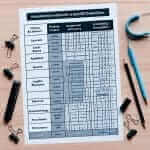The IELTS Writing exam is often seen as one of the most challenging sections, requiring a strong grasp of English grammar, vocabulary, and the ability to structure coherent and compelling arguments. Whether you’re aiming for a band 7 or aiming even higher, understanding the nuances of the writing tasks is crucial. This guide, crafted from my 20 years of experience teaching IELTS, delves deep into the structure, expectations, and effective strategies for both Writing Task 1 and Task 2.
Understanding the IELTS Writing Tasks
The IELTS Writing test is divided into two tasks, each assessing different writing skills:
IELTS Writing Task 1: Analyzing Visual Information
What is it?
In Task 1, you’ll be presented with a visual representation of information. This could be:
- A graph (line graph, bar chart, pie chart)
- A table
- A diagram illustrating a process
- A map showing changes over time
What are you expected to do?
Your task is to summarize, analyze, and report the main features of the visual data in your own words. This involves:
- Paraphrasing: Rephrasing the information given in the question prompt.
- Highlighting key trends: Identifying the most significant changes, patterns, or differences.
- Supporting your observations: Using data from the visual to back up your statements.
Word limit: At least 150 words. Aim to complete this task within 20 minutes to allocate sufficient time for Task 2.
IELTS Writing Task 2: The Essay
What is it?
Task 2 requires you to write an essay in response to a given point of view, argument, or problem. The topics are diverse and can range from education and technology to social issues and the environment.
What are you expected to do?
You need to present a well-structured essay that:
- Addresses all parts of the question: Ensure you understand the prompt fully and address each aspect.
- Presents a clear position: State your opinion clearly and maintain it throughout the essay.
- Develops your arguments logically: Use examples and evidence to support your stance.
- Uses a range of vocabulary and grammatical structures: Showcase your language proficiency.
Word limit: At least 250 words. Aim to spend approximately 40 minutes on this task.
Sample IELTS Writing Tasks and Tips
Task 1 Example: Line Graph
 Line Graph for IELTS Writing Task 1
Line Graph for IELTS Writing Task 1
Question: The line graph illustrates the population figures for three different countries over a 50-year period. Summarize the information by selecting and reporting the main features, and make comparisons where relevant.
Tips:
- Paraphrase the question prompt: Begin by stating what the graph shows, but in your own words. For example: “The graph provides an overview of population growth in countries A, B, and C from 1970 to 2020.”
- Focus on the most significant trends: Don’t feel the need to describe every single data point. Instead, highlight the most noticeable increases, decreases, or fluctuations.
- Use appropriate vocabulary for describing trends: Familiarize yourself with words and phrases like “sharp rise,” “gradual decline,” “plateau,” “fluctuate,” etc.
- Make comparisons: Draw comparisons between the countries, highlighting any similarities or differences in their population trends.
Task 2 Example: Opinion Essay
Question: Some people believe that the best way to reduce crime is to impose stricter punishments on criminals. To what extent do you agree or disagree?
Tips:
- Structure your essay clearly: Use paragraphs to separate your introduction, body paragraphs (presenting your arguments and supporting evidence), and conclusion.
- State your position clearly in the introduction: Do you agree, disagree, or partially agree?
- Develop your arguments logically: Each body paragraph should focus on a single main idea, supported by reasons and examples.
- Use a range of vocabulary and grammar: Show off your language skills by using a variety of sentence structures, vocabulary, and grammatical forms.
- Don’t forget to conclude: Summarize your main points and restate your position.
Key Takeaways
- The IELTS Writing test requires a strategic approach. Understand the specific requirements of each task.
- Practice analyzing visual data and writing essays on a variety of topics to build your confidence.
- Focus on presenting clear, well-structured, and well-supported arguments.
- Strive for accuracy in your grammar and vocabulary usage.
By understanding the expectations of the IELTS Writing tasks and consistently practicing your skills, you’ll be well-equipped to achieve your desired band score.


